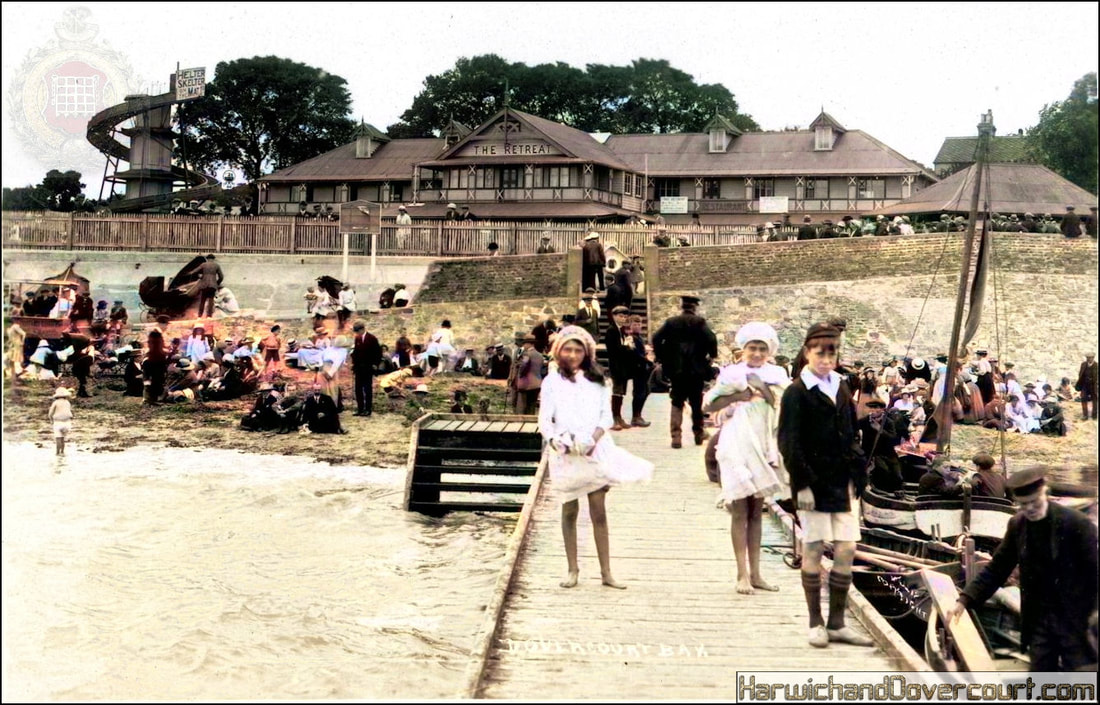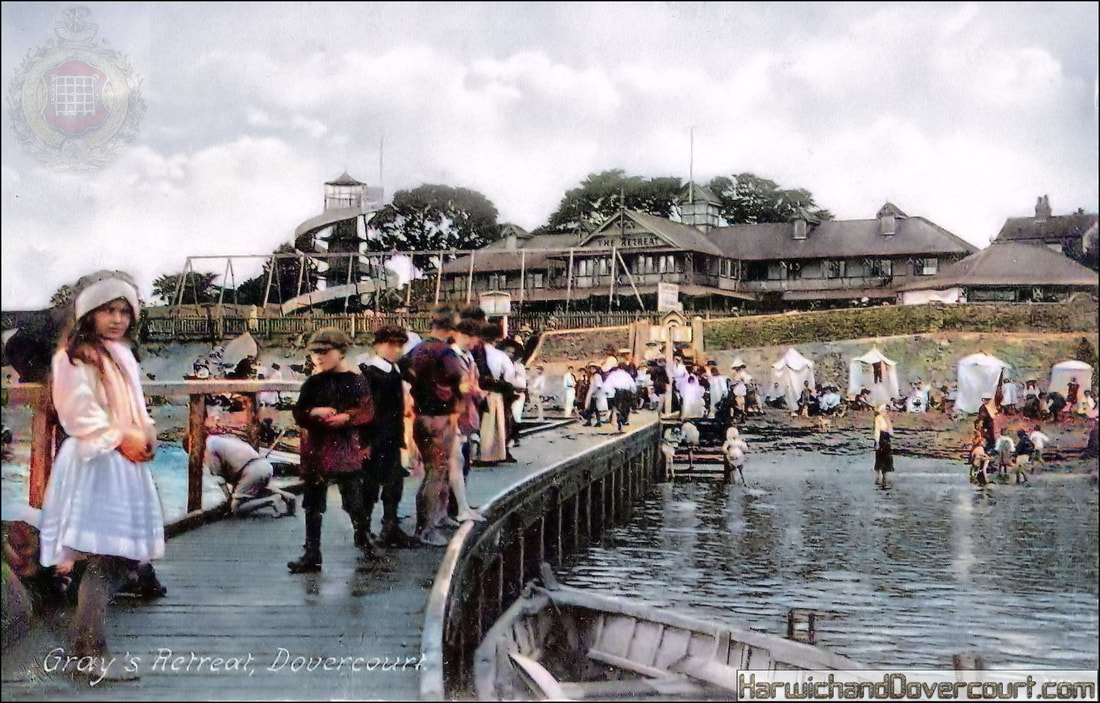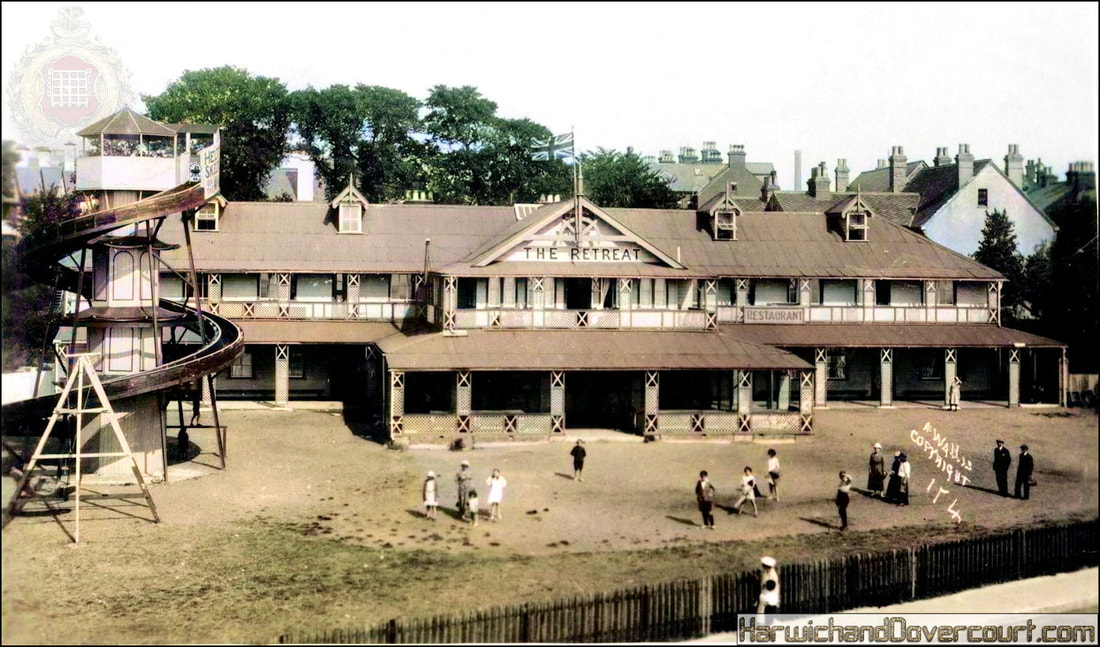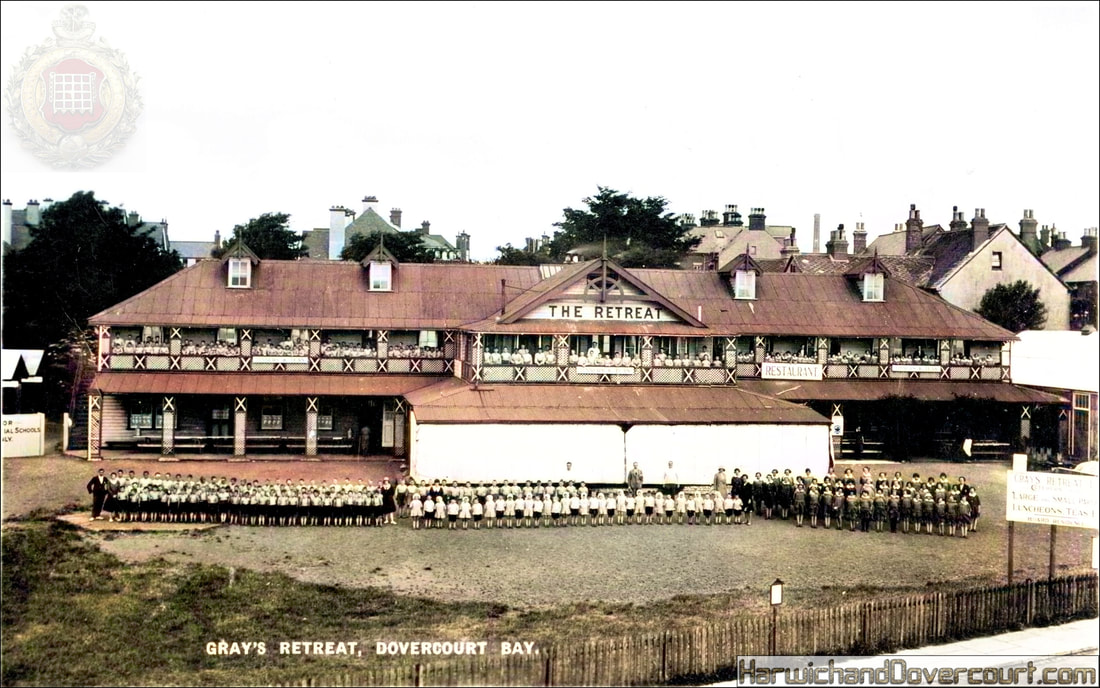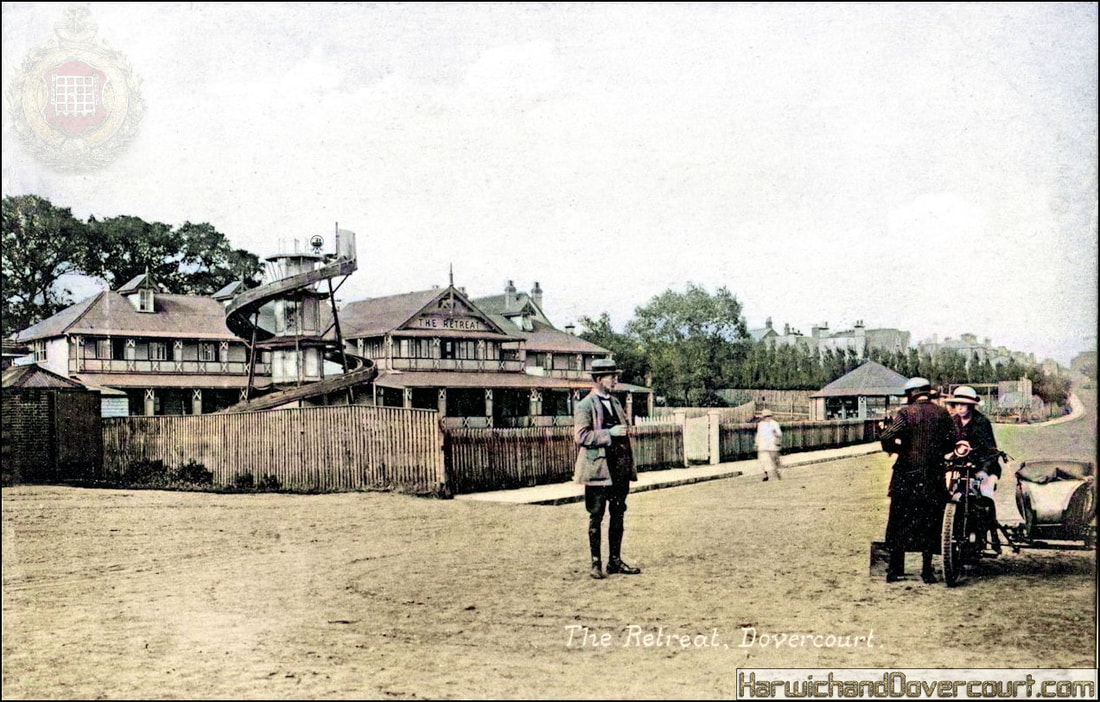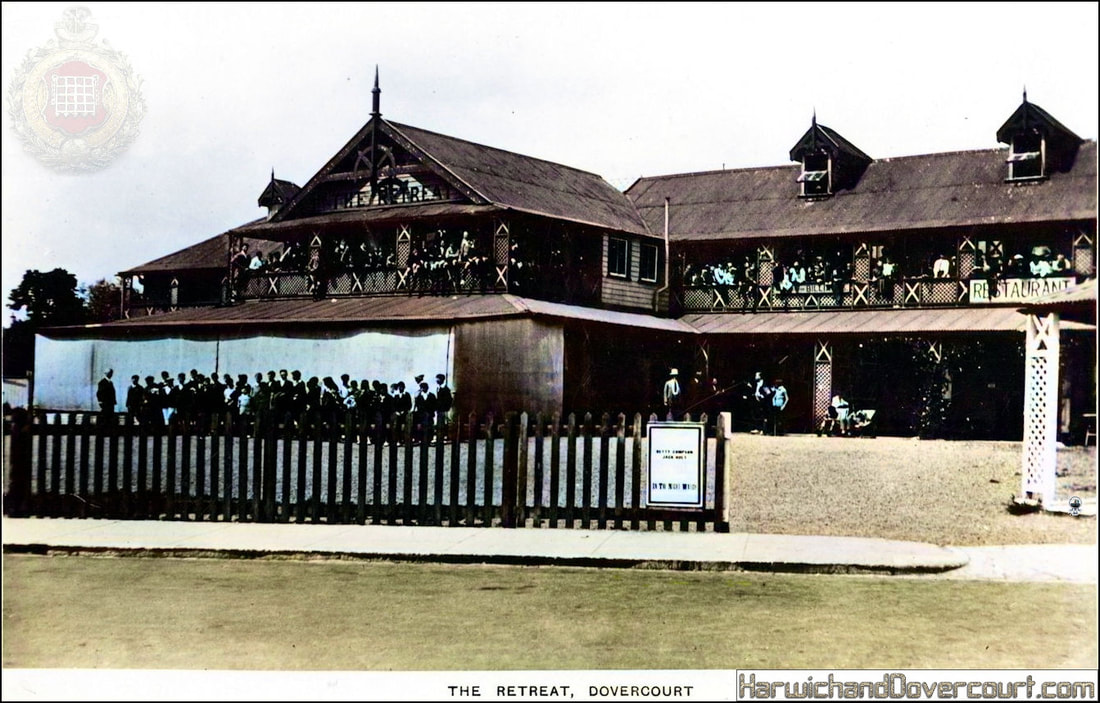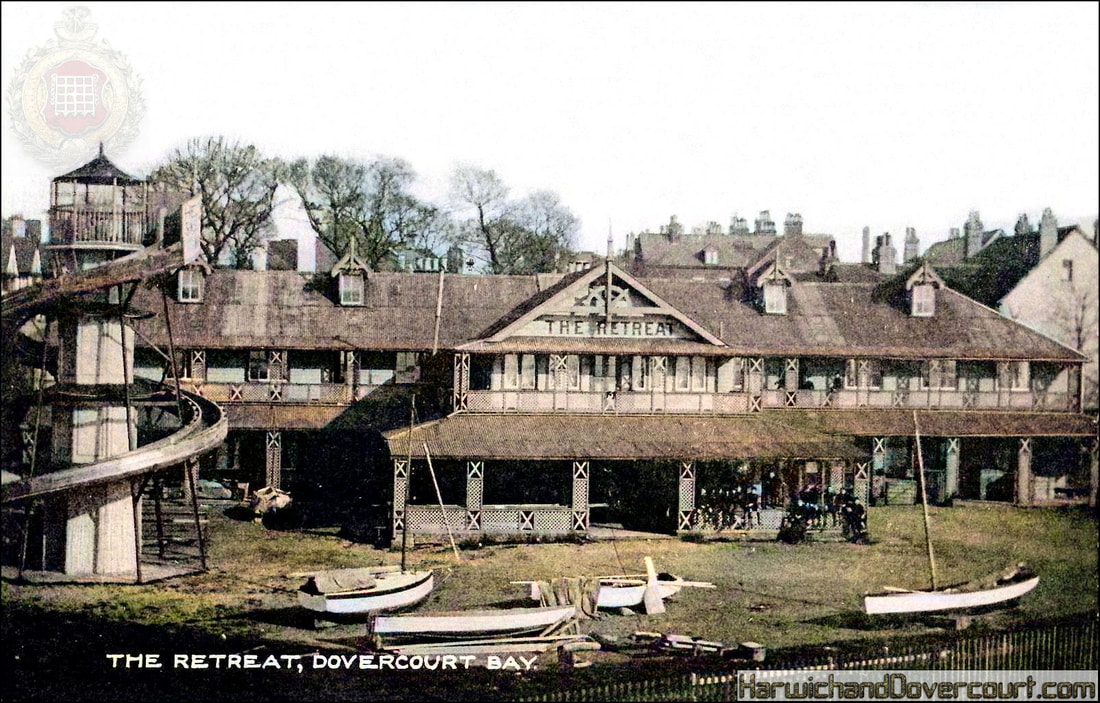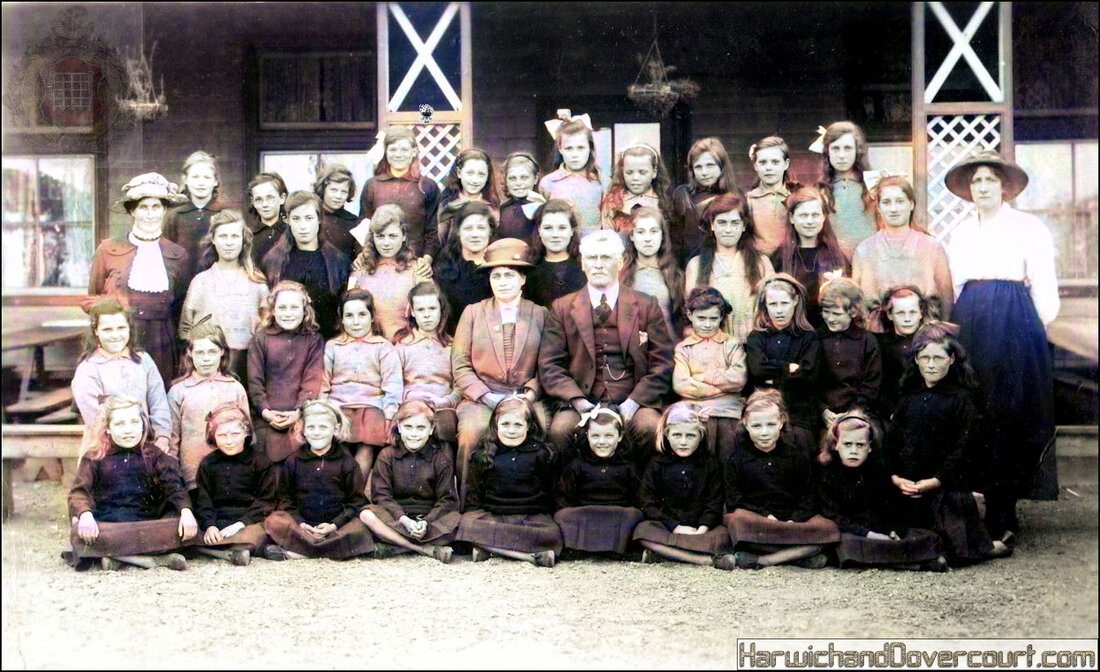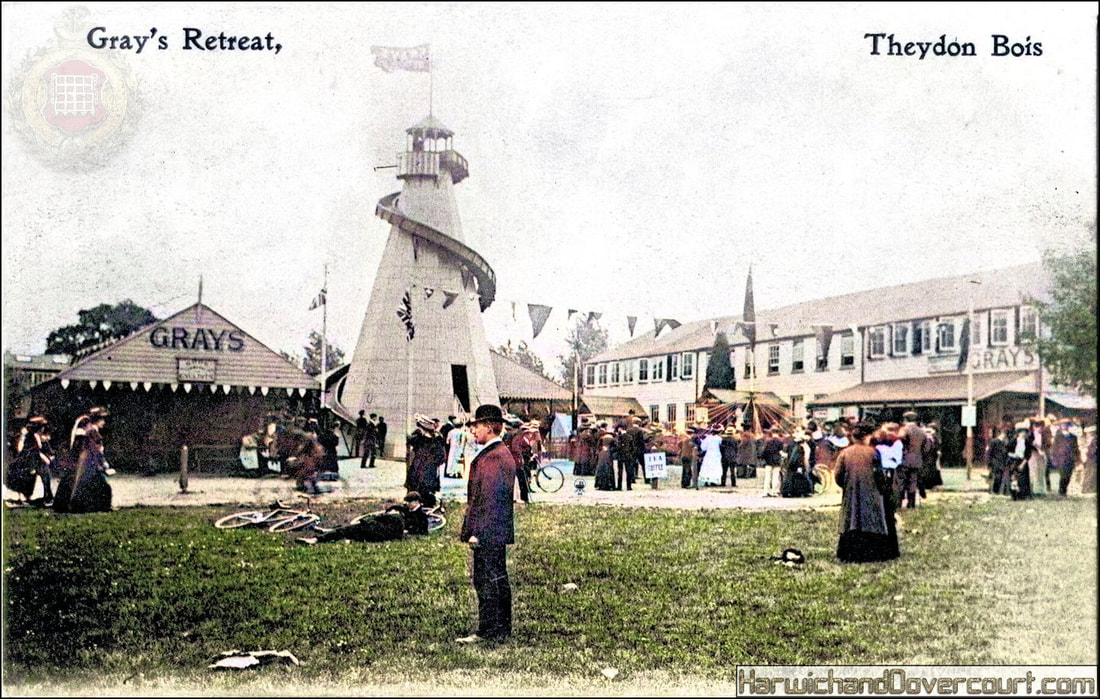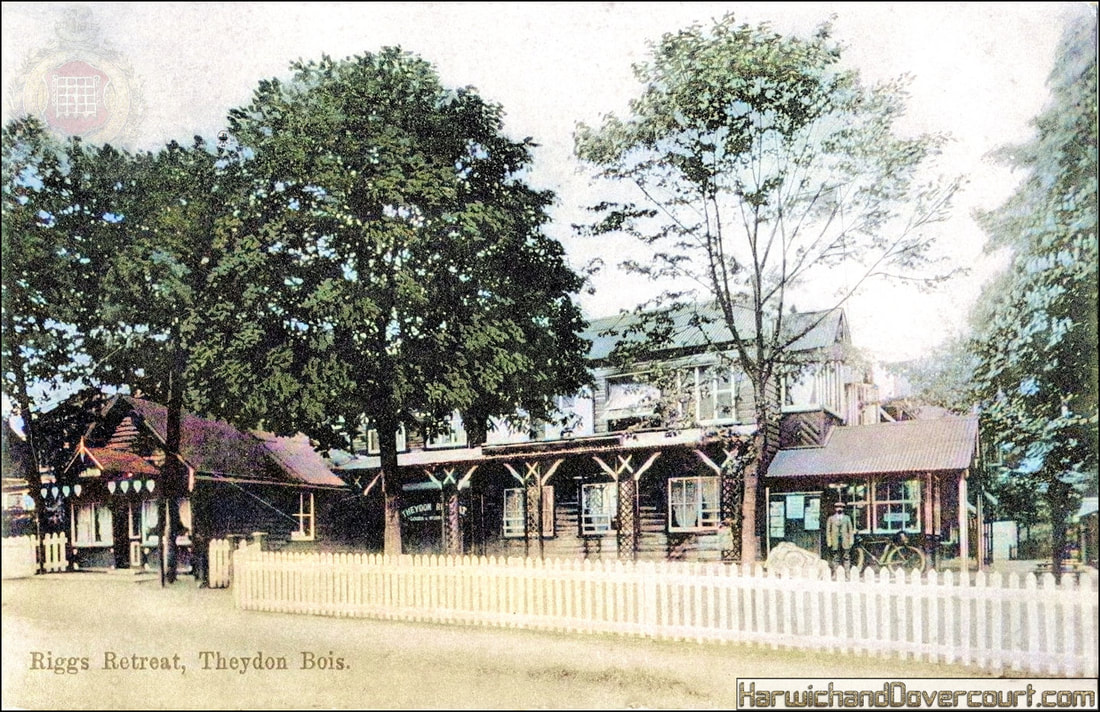~ "The Retreat" &/or "Gray's Retreat" at Dovercourt Bay, Essex ~
These views illustrate well the "Greys Retreat" which was opposite the Dovercourt Light houses near the bottom of Beach Road. There were several retreats in Essex as far away as Epping Forest, which provided entertainment and refreshments for day trippers. The arrival of the railway in Dovercourt, made it easier for many more people to visit the retreats. The size of the refreshment hall shows how they could cope with hundreds of people at a time. The retreats often weren't that popular with local people owing to the noise and mess created by the huge numbers of people visiting them.
The seaside retreats opened by the Riggs family included the Dovercourt Retreat built in 1889, which was later sold in 1892 to W.F. and H.Gray, who lived and raised their families there until 1906 when W.F. Gray moved from Dovercourt and took over another retreat at Theydon Bois.
Despite the move, the Grays retained an interest in the Dovercourt business which as a limited liability company continued trading until 1959. An entry in the Herts and Essex Trades Directory for 1958-9 gives the information that as a restaurant and café at the Lower Marine Parade the firm was still operating. Shortly afterwards it went into liquidation and the site was purchased by the local Council.
Gray's 'Temperance' Retreat composed of two storeys could accommodate 2,000 people, it was a predominantly wooden construction with a tea, rooms, restaurant and a dance floor. School and Church outings were common, with groups of children sleeping in the long dormitories. In both World Wars it was requisitioned as billets for soldiers and then fell into disrepair before being demolished in the 1950s.
The seaside retreats opened by the Riggs family included the Dovercourt Retreat built in 1889, which was later sold in 1892 to W.F. and H.Gray, who lived and raised their families there until 1906 when W.F. Gray moved from Dovercourt and took over another retreat at Theydon Bois.
Despite the move, the Grays retained an interest in the Dovercourt business which as a limited liability company continued trading until 1959. An entry in the Herts and Essex Trades Directory for 1958-9 gives the information that as a restaurant and café at the Lower Marine Parade the firm was still operating. Shortly afterwards it went into liquidation and the site was purchased by the local Council.
Gray's 'Temperance' Retreat composed of two storeys could accommodate 2,000 people, it was a predominantly wooden construction with a tea, rooms, restaurant and a dance floor. School and Church outings were common, with groups of children sleeping in the long dormitories. In both World Wars it was requisitioned as billets for soldiers and then fell into disrepair before being demolished in the 1950s.
~ 01 ~ "The Retreat" from the Jetty, Dovercourt Bay (1920) Wallis H&D ~
~ 02 "Gray's Retreat", Dovercourt Bay (1914) H&D ~
~ 03 ~ #174 "The Retreat", Dovercourt Bay, Essex (1925) F.Wallis H&D ~
~ 04 ~ "Gray's Retreat" Dovercourt Bay (1929) by Eastern Cards H&D ~
~ 05 ~ #12289 - 2064 "The Retreat", Dovercourt Bay (1922) V&L H&D ~
12289 - 2064 The Retreat, Dovercourt (1922) V&L Publishing
This postcard appears to show Frederick Percy Wallis and two of his daughters including Winifred, who ran a photographic studio between 1918 and 1924, along with a kiosk on the beach at Dovercourt. They managed to produce a vast array of interesting postcards of local importance, covering events and places.
However both photographers, were also busy alongside holiday makers and residents alike, drumming up even further business.
Their legacy provides a rich array of social history, although identifying, people and places.
Other cards in this series produced around 1921 - 22 covered the Dovercourt area, rather than Harwich.
This postcard appears to show Frederick Percy Wallis and two of his daughters including Winifred, who ran a photographic studio between 1918 and 1924, along with a kiosk on the beach at Dovercourt. They managed to produce a vast array of interesting postcards of local importance, covering events and places.
However both photographers, were also busy alongside holiday makers and residents alike, drumming up even further business.
Their legacy provides a rich array of social history, although identifying, people and places.
Other cards in this series produced around 1921 - 22 covered the Dovercourt area, rather than Harwich.
~ 06 ~ "The Retreat", Dovercourt Bay (1928) Kingsway H&D ~
~ 07 ~ "The Retreat", Dovercourt Bay (1925) H&D ~
~ 08 ~ Mitcham School Children at the Retreat, Dovercourt (1922) H&D ~
London School Children visiting Gray's 'Temperance' Retreat, Dovercourt in 1922
John Riggs who formed the idea of a "Retreat" for the supply of non-alcoholic refreshments built this timber construction in 1889, opposite the Lighthouses, to cater for increasing visitors to Dovercourt. The Retreat was used by schools, scouts, work outings and even the Military during both world wars.
John Riggs who formed the idea of a "Retreat" for the supply of non-alcoholic refreshments built this timber construction in 1889, opposite the Lighthouses, to cater for increasing visitors to Dovercourt. The Retreat was used by schools, scouts, work outings and even the Military during both world wars.
~ 09 ~ 10th Bedfordshire Regiment, Dovercourt (1914) Steggles H&D ~
~ Billeted at the Retreat ~
The 10th (Service) Battalion of the Bedfordshire Reserves at the Retreat, Dovercourt, Essex in November 1914
This Military card at the start of World War One, shows troops billeted at Greys Retreat opposite the Dovercourt Light houses near Beach Road. There were several retreats in Essex as far away as Epping Forest, which provided entertainment and refreshments for day trippers.
This photographic card of a Sergeant with his section serving with the 10th Battalion, Bedfordshire Regiment, wearing Kitchener's Blues, was produced by F.G. Steggles, photographers based at Dovercourt.
The 10th (Service) Battalion was raised in November 1914 as a part of Lord Kitchener's K4 Army Group, within the 106th Brigade, 35th Division. It remained in England as a 'Reserve' battalion, being based at Dovercourt from its formation and moving to White City in January 1915. In May 1915 they moved to Colchester, then back to Dovercourt in March 1916. The battalion was redesignated as the 27th Battalion of the newly formed Training Reserve in September 1916.
This Military card at the start of World War One, shows troops billeted at Greys Retreat opposite the Dovercourt Light houses near Beach Road. There were several retreats in Essex as far away as Epping Forest, which provided entertainment and refreshments for day trippers.
This photographic card of a Sergeant with his section serving with the 10th Battalion, Bedfordshire Regiment, wearing Kitchener's Blues, was produced by F.G. Steggles, photographers based at Dovercourt.
The 10th (Service) Battalion was raised in November 1914 as a part of Lord Kitchener's K4 Army Group, within the 106th Brigade, 35th Division. It remained in England as a 'Reserve' battalion, being based at Dovercourt from its formation and moving to White City in January 1915. In May 1915 they moved to Colchester, then back to Dovercourt in March 1916. The battalion was redesignated as the 27th Battalion of the newly formed Training Reserve in September 1916.
